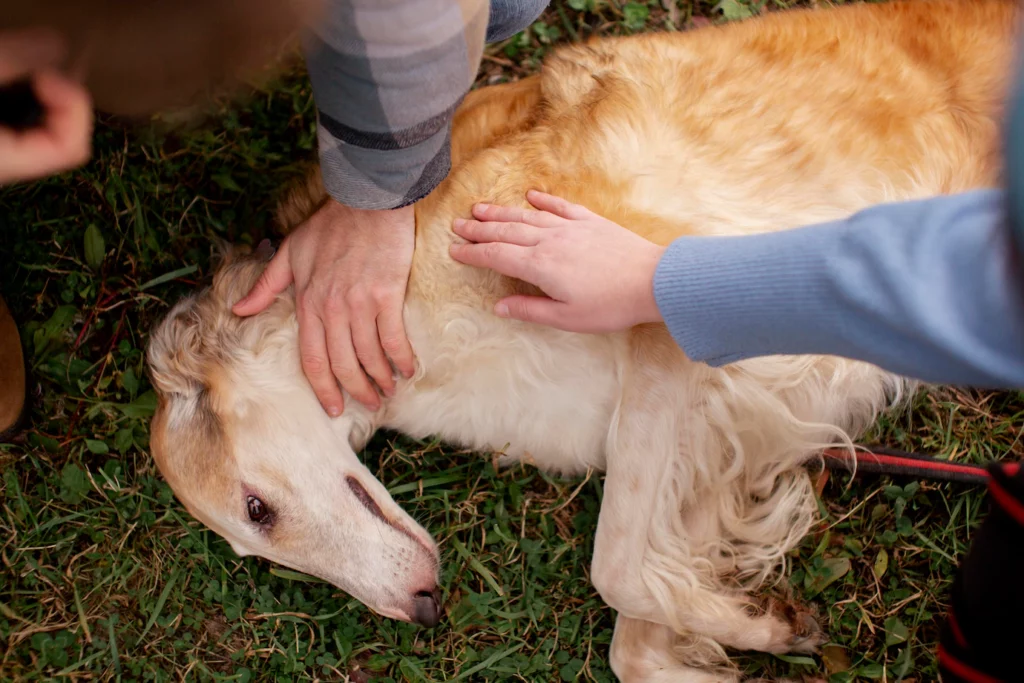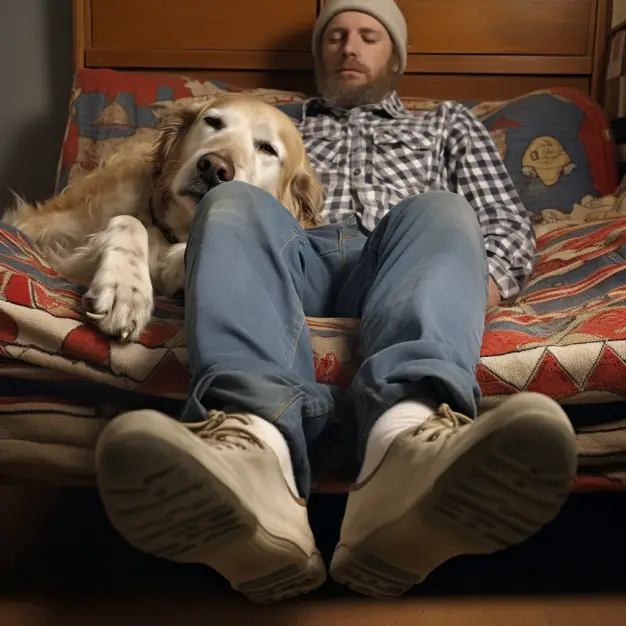Help! Back Leg of Dog Shaking: Causes and Solutions
If you’re a dog parent, you’ve likely experienced those heart-melting moments when your dog’s tail wags excitedly at your arrival, or they do the ‘zoomies’ around your living room.
But when it comes to your dog’s back legs shaking, it can leave you puzzled and worried. Is this a sign of joy, cold, or could it be something more serious?
While it might be quite startling to see your pet’s leg shaking, rest assured that you’re not alone in this concern. Many dog owners observe this behavior and wonder what’s causing it. That’s exactly why we’re here to help!
In this blog post, we’re going to dive deep into understanding the causes behind the back leg of your dog shaking and explore various solutions to ensure the utmost comfort and health for your furry friend.
Whether it’s a passing muscle twitch or a symptom of a more significant health issue, we’ve got you covered with comprehensive and easy-to-understand information.
So, are you ready to unravel this mystery and become an even better-informed pet parent?
Let’s get started!
Key takeaways
Back leg shaking in dogs can be due to numerous causes including health conditions and environmental factors.
The timing and situation of the shaking is crucial for effective diagnosis.
Vets utilize various diagnostic tests to determine the cause.
Treatment is multifaceted and varies based on the underlying cause.
Regular vet check-ups, proper diet, exercise, and a stress-free environment help in prevention.
Proactive care is key in minimizing health risks.
Always consult a professional veterinarian for advice.
Why Are My Dog’s Back Leg Shaking?
Have you ever noticed your dog’s back legs trembling after a good run in the park or during a particularly chilly day? A little shaking in dogs is quite normal in these instances. But if you see their back legs shaking persistently or more often than seems natural, it’s time to look a bit closer.
The reasons behind this shaking could range from simple causes to more complex health conditions. For example, it could be a natural response to cold weather, as dogs, like humans, shiver when it’s cold. However, if you’ve ruled out environmental factors and the shaking continues, it might be time to dig a little deeper.
A host of different health issues, from degenerative diseases and neurological problems to muscle weakness, and even anxiety, could potentially cause your dog’s back legs to shake.
Aging, in particular, brings about various changes in your pet’s body, and older dogs might experience back-leg shaking due to decreasing muscle strength or the onset of conditions like arthritis.
But don’t fret! Even if it’s a health issue causing your pet’s shaking, early detection can make a world of difference. Veterinary care is invaluable in these situations, with professionals capable of diagnosing and treating underlying conditions.
What’s more, your role as a loving pet owner is just as crucial. Regular exercise, balanced nutrition, and stress management can help your dog maintain good health and potentially alleviate symptoms like back-leg shaking.
Remember, every dog is unique, and their shaking might have different causes and solutions. But as you understand more about why your dog’s back leg might be shaking, you’ll be better prepared to ensure their comfort and well-being!

Dive into Causes of Back Leg Tremors in Dogs
Shaking or trembling in your dog’s back legs might have you wondering: “What’s going on?” While it can indeed be puzzling, understanding the potential causes can help demystify this behavior. So let’s take a closer look.
First off, degenerative disorders can often lead to symptoms like back leg shaking. Conditions like hip dysplasia and degenerative myelopathy are quite common in some breeds. These ailments often lead to progressive weakness and loss of function in the hind legs, which can result in shaking.
Next on the list are neurological problems. You might not know this, but conditions like Wobbler’s syndrome or cerebellar ataxia can also cause your dog’s back legs to shake. These disorders impact the nervous system, affecting your pet’s balance and coordination, which may manifest as shaking.
As your furry friend grows older, they may naturally lose some muscle strength. This aging and muscle weakness can lead to trembling or shaking in their back legs. It’s a part of their life cycle, but that doesn’t mean we can’t find ways to help them cope better.
Ever seen your dog shake during a thunderstorm or fireworks? Stress and anxiety can cause a physical response in dogs, just like in humans. If your dog is feeling particularly anxious or stressed, they might show it through behaviors like back leg shaking.
Finally, arthritis is a common issue in older dogs, leading to pain, stiffness, and yes, shaking in the back legs. If your senior dog is showing these symptoms, it’s essential to get them checked out and manage their discomfort effectively.
Remember, these are just a few potential causes, and the actual reason behind your dog’s back leg shaking could vary. If you’re noticing persistent shaking, it’s always a good idea to consult with your vet for professional advice.
Contextualizing Back Legs Shaking in Dogs
Now that we’ve explored the potential causes, let’s try to understand the context of your dog’s back leg shaking. Dogs communicate a lot through their body language, and identifying the circumstances when the shaking occurs can be insightful.
Perhaps you’ve noticed your dog’s back legs shaking while standing. This could be due to muscle fatigue, especially if they’ve been active or standing for extended periods. On the flip side, it might also be a sign of underlying conditions like degenerative diseases or arthritis causing discomfort while bearing weight.
Sometimes, shaking might occur while your dog is resting. If you see your dog’s back legs shaking while lying down, it may be due to discomfort or restlessness. They could be trying to find a comfortable position or might be experiencing pain that’s causing the shaking.
But what if the shaking happens after some physical activity? Some pet owners have observed their dog’s quivering back legs after exercise. In this case, it could be a result of muscle strain or fatigue, particularly if the exercise was intense or your dog is not regularly active. However, continuous shaking even after rest could signal something more serious, like a neurological problem, and should be evaluated by a vet.
And for our senior furry friends, an old dog’s back legs shaking is a more common observation. It’s usually a sign of age-related changes like arthritis or muscle weakness, although other health issues can’t be ruled out.
Importantly, arthritis can affect any of your dog’s legs. So, if you see your dog’s back left leg shaking or the back right leg shaking, it might be due to localized discomfort or pain.
Understanding these contexts is important because it gives you a better chance to observe and report these symptoms to your vet accurately. However, do keep in mind that only a professional vet can diagnose these conditions effectively.
Related:
Finding Solutions: From Diagnosis to Treatment
While it can be worrying to see your dog’s back legs shaking, remember that understanding the problem is half the battle won. With the right approach and treatment, you can help your furry friend lead a comfortable life. Here’s what you need to know about diagnosis and treatment options.
Firstly, diagnosing the cause of your dog’s back leg shaking is essential, as it guides the treatment process. Your vet may perform a series of tests, including physical examinations, blood tests, x-rays, or even an MRI, depending on the suspected cause.
If the shaking is due to degenerative diseases, treatment options might include medication to manage pain and inflammation, physical therapy, or even surgery in some cases. For issues related to neurological problems, management usually involves treating the underlying condition with medication, supportive care, and occasionally surgery.
When the shaking is due to aging or muscle weakness, your vet may recommend changes in diet, a controlled exercise regimen, and sometimes even therapeutic massages to strengthen your dog’s muscles.
For dogs experiencing stress and anxiety, creating a calm environment can help. Behavior modification therapy, training, and sometimes anti-anxiety medications can be beneficial in managing your pet’s stress levels.
In the case of arthritis, treatment typically involves managing pain and inflammation with medication, weight control, and joint supplements. Regular, gentle exercise can also help keep your dog’s joints flexible.
The treatment for your dog’s back leg shaking will depend on the diagnosed cause. Always remember, professional veterinary advice is vital in these situations. With their guidance and your loving care, your dog can enjoy a happy, comfortable life, regardless of whether their back leg shakes or not.

Proactive Prevention: Reducing the Risk of ‘Back Leg of Dog Shaking’
We’ve all heard the old saying, “prevention is better than cure,” and this certainly rings true when it comes to your dog’s health. While you might not be able to prevent all causes of back leg shaking in dogs, there are steps you can take to reduce the risk and ensure your dog’s overall health and well-being.
One of the best ways to prevent health issues in dogs is to provide them with regular exercise. A good daily walk or play session can help maintain your dog’s muscle strength and joint flexibility, reducing the risk of muscle weakness and arthritis that can cause shaking.
In addition to exercise, a balanced diet plays a pivotal role in your dog’s health. Feed your dog a diet that is appropriate for their age, breed, and health status. Your vet can provide the best advice on what your dog’s diet should include.
Regular vet check-ups are also crucial for early detection of potential health issues. Regular exams allow your vet to catch any early signs of degenerative diseases or other conditions that may lead to back leg shaking.
Don’t underestimate the power of a stress-free environment. If your dog’s shaking is caused by stress or anxiety, try to identify and eliminate the sources of stress. Provide them with a quiet and comfortable space, and use positive reinforcement training to help them cope with stressful situations.
Lastly, consider weight management. Overweight dogs are more prone to health issues like arthritis and other joint-related problems that can cause back-leg shaking. Regular exercise and a controlled diet can help manage your dog’s weight and keep these issues at bay.
These preventive measures can go a long way in maintaining your pet’s health and reducing the risk of issues like back leg shaking. Remember, your dog depends on you for their well-being, so these proactive steps can make a significant difference.
Related:
Final Thoughts
Seeing your beloved pet’s back legs shaking can certainly be alarming. However, understanding the possible causes and knowing what to look for can help put your mind at ease and ensure you’re ready to take appropriate action.
Whether it’s age-related muscle weakness, stress, or more serious health conditions like degenerative diseases or neurological issues, shaking in your dog’s back legs can be a symptom of various factors. However, with early detection, professional veterinary care, and your attentive love and support, your dog can lead a comfortable and happy life.
Remember to stay vigilant about changes in your dog’s behavior, keep up with regular vet check-ups, and maintain a balanced diet and exercise regimen for your furry friend. After all, your proactive care can make a world of difference to your pet’s well-being.
Let’s face it, dogs are more than just pets, they’re family. And like any family member, we want them to be happy and healthy. So, as a pet parent, keep learning, stay informed, and continue to provide the best care for your canine companion.
References
- Wrigleyville Veterinary Center. (n.d.). Why are my dog’s back legs shaking? Retrieved June 18, 2023, from https://wrigleyvillevet.com/blog/why-are-my-dogs-back-legs-shaking/
- K9 Carts. (n.d.). Leg tremors in dogs. Retrieved June 18, 2023, from https://k9carts.com/leg-tremors-in-dogs/
- Handicapped Pets. (n.d.). Leg tremors in dogs. Retrieved June 18, 2023, from https://www.handicappedpets.com/blog/leg-tremors-in-dogs/
- Authentica Pets. (n.d.). Leg tremors in dogs – dogs back legs shaking: Why? Retrieved June 18, 2023, from https://authenticapets.com/en/blog/leg-tremors-dogs-dogs-back-legs-shaking-why

![What Smell Do Dogs Hate to Pee On? [Top 5 Scents & More]](https://www.warmlypet.com/wp-content/uploads/2023/04/What-Smells-Do-Dogs-Hate-To-Pee-On-768x512.webp)




